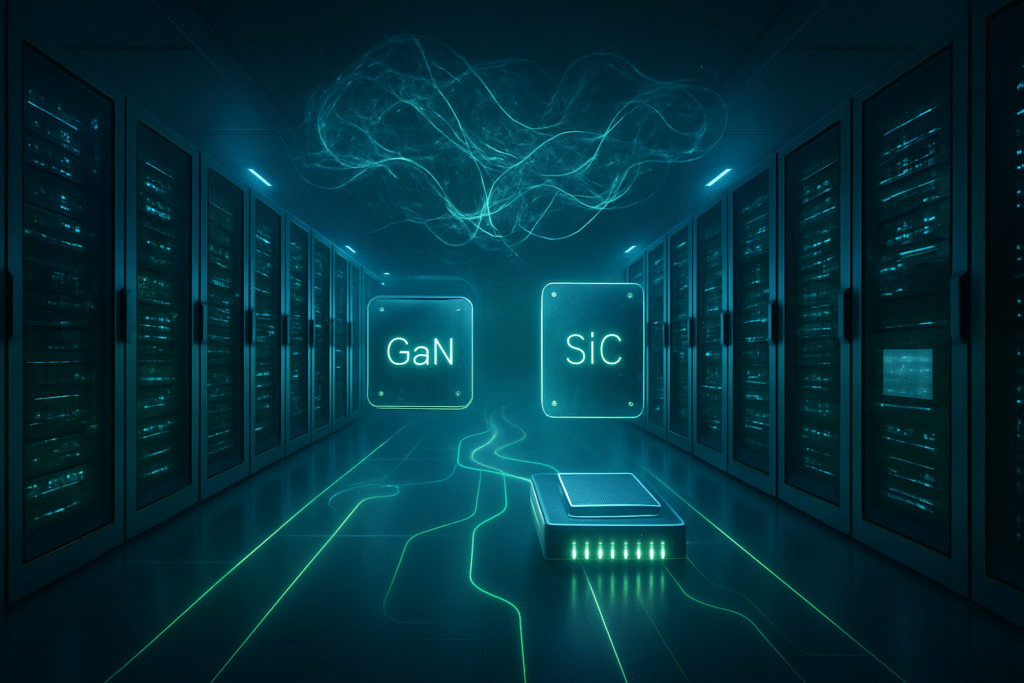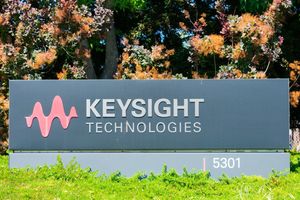
Sunnyvale, CA – October 14, 2025 – In a pivotal moment for the future of artificial intelligence infrastructure, Navitas Semiconductor (NASDAQ: NVTS) has announced a groundbreaking suite of power semiconductors specifically engineered to power Nvidia's (NASDAQ: NVDA) ambitious 800 VDC "AI factory" architecture. Unveiled yesterday, October 13, 2025, these advanced Gallium Nitride (GaN) and Silicon Carbide (SiC) devices are poised to deliver unprecedented energy efficiency and performance crucial for the escalating demands of next-generation AI workloads and hyperscale data centers. This development marks a significant leap in power delivery, addressing one of the most pressing challenges in scaling AI—the immense power consumption and thermal management.
The immediate significance of Navitas's new product line cannot be overstated. By enabling Nvidia's innovative 800 VDC power distribution system, these power chips are set to dramatically reduce energy losses, improve overall system efficiency by up to 5% end-to-end, and enhance power density within AI data centers. This architectural shift is not merely an incremental upgrade; it represents a fundamental re-imagining of how power is delivered to AI accelerators, promising to unlock new levels of computational capability while simultaneously mitigating the environmental and operational costs associated with massive AI deployments. As AI models grow exponentially in complexity and size, efficient power management becomes a cornerstone for sustainable and scalable innovation.
Technical Prowess: Powering the AI Revolution with GaN and SiC
Navitas Semiconductor's new product portfolio is a testament to the power of wide-bandgap materials in high-performance computing. The core of this innovation lies in two distinct categories of power devices tailored for different stages of Nvidia's 800 VDC power architecture:
Firstly, 100V GaN FETs (Gallium Nitride Field-Effect Transistors) are specifically optimized for the critical lower-voltage DC-DC stages found directly on GPU power boards. In these highly localized environments, individual AI chips can draw over 1000W of power, demanding power conversion solutions that offer ultra-high density and exceptional thermal management. Navitas's GaN FETs excel here due to their superior switching speeds and lower on-resistance compared to traditional silicon-based MOSFETs, minimizing energy loss right at the point of consumption. This allows for more compact power delivery modules, enabling higher computational density within each AI server rack.
Secondly, for the initial high-power conversion stages that handle the immense power flow from the utility grid to the 800V DC backbone of the AI data center, Navitas is deploying a combination of 650V GaN devices and high-voltage SiC (Silicon Carbide) devices. These components are instrumental in rectifying and stepping down the incoming AC power to the 800V DC rail with minimal losses. The higher voltage handling capabilities of SiC, coupled with the high-frequency switching and efficiency of GaN, allow for significantly more efficient power conversion across the entire data center infrastructure. This multi-material approach ensures optimal performance and efficiency at every stage of power delivery.
This approach fundamentally differs from previous generations of AI data center power delivery, which typically relied on lower voltage (e.g., 54V) DC systems or multiple AC/DC and DC/DC conversion stages. The 800 VDC architecture, facilitated by Navitas's wide-bandgap components, streamlines power conversion by reducing the number of conversion steps, thereby maximizing energy efficiency, reducing resistive losses in cabling (which are proportional to the square of the current), and enhancing overall system reliability. For example, solutions leveraging these devices have achieved power supply units (PSUs) with up to 98% efficiency, with a 4.5 kW AI GPU power supply solution demonstrating an impressive power density of 137 W/in³. Initial reactions from the AI research community and industry experts have been overwhelmingly positive, highlighting the critical need for such advancements to sustain the rapid growth of AI and acknowledging Navitas's role in enabling this crucial infrastructure.
Market Dynamics: Reshaping the AI Hardware Landscape
The introduction of Navitas Semiconductor's advanced power solutions for Nvidia's 800 VDC AI architecture is set to profoundly impact various players across the AI and tech industries. Nvidia (NASDAQ: NVDA) stands to be a primary beneficiary, as these power semiconductors are integral to the success and widespread adoption of its next-generation AI infrastructure. By offering a more energy-efficient and high-performance power delivery system, Nvidia can further solidify its dominance in the AI accelerator market, making its "AI factories" more attractive to hyperscalers, cloud providers, and enterprises building massive AI models. The ability to manage power effectively is a key differentiator in a market where computational power and operational costs are paramount.
Beyond Nvidia, other companies involved in the AI supply chain, particularly those manufacturing power supplies, server racks, and data center infrastructure, stand to benefit. Original Design Manufacturers (ODMs) and Original Equipment Manufacturers (OEMs) that integrate these power solutions into their server designs will gain a competitive edge by offering more efficient and dense AI computing platforms. This development could also spur innovation among cooling solution providers, as higher power densities necessitate more sophisticated thermal management. Conversely, companies heavily invested in traditional silicon-based power management solutions might face increased pressure to adapt or risk falling behind, as the efficiency gains offered by GaN and SiC become industry standards for AI.
The competitive implications for major AI labs and tech companies are significant. As AI models become larger and more complex, the underlying infrastructure's efficiency directly translates to faster training times, lower operational costs, and greater scalability. Companies like Google (NASDAQ: GOOGL), Microsoft (NASDAQ: MSFT), Amazon (NASDAQ: AMZN), and Meta (NASDAQ: META), all of whom operate vast AI data centers, will likely prioritize adopting systems that leverage such advanced power delivery. This could disrupt existing product roadmaps for internal AI hardware development if their current power solutions cannot match the efficiency and density offered by Nvidia's 800V architecture enabled by Navitas. The strategic advantage lies with those who can deploy and scale AI infrastructure most efficiently, making power semiconductor innovation a critical battleground in the AI arms race.
Broader Significance: A Cornerstone for Sustainable AI Growth
Navitas's advancements in power semiconductors for Nvidia's 800V AI architecture fit perfectly into the broader AI landscape and current trends emphasizing sustainability and efficiency. As AI adoption accelerates globally, the energy footprint of AI data centers has become a significant concern. This development directly addresses that concern by offering a path to significantly reduce power consumption and associated carbon emissions. It aligns with the industry's push towards "green AI" and more environmentally responsible computing, a trend that is gaining increasing importance among investors, regulators, and the public.
The impact extends beyond just energy savings. The ability to achieve higher power density means that more computational power can be packed into a smaller physical footprint, leading to more efficient use of real estate within data centers. This is crucial for "AI factories" that require multi-megawatt rack densities. Furthermore, simplified power conversion stages can enhance system reliability by reducing the number of components and potential points of failure, which is vital for continuous operation of mission-critical AI applications. Potential concerns, however, might include the initial cost of migrating to new 800V infrastructure and the supply chain readiness for wide-bandgap materials, although these are typically outweighed by the long-term operational benefits.
Comparing this to previous AI milestones, this development can be seen as foundational, akin to breakthroughs in processor architecture or high-bandwidth memory. While not a direct AI algorithm innovation, it is an enabling technology that removes a significant bottleneck for AI's continued scaling. Just as faster GPUs or more efficient memory allowed for larger models, more efficient power delivery allows for more powerful and denser AI systems to operate sustainably. It represents a critical step in building the physical infrastructure necessary for the next generation of AI, from advanced generative models to real-time autonomous systems, ensuring that the industry can continue its rapid expansion without hitting power or thermal ceilings.
The Road Ahead: Future Developments and Predictions
The immediate future will likely see a rapid adoption of Navitas's GaN and SiC solutions within Nvidia's ecosystem, as AI data centers begin to deploy the 800V architecture. We can expect to see more detailed performance benchmarks and case studies emerging from early adopters, showcasing the real-world efficiency gains and operational benefits. In the near term, the focus will be on optimizing these power delivery systems further, potentially integrating more intelligent power management features and even higher power densities as wide-bandgap material technology continues to mature. The push for even higher voltages and more streamlined power conversion stages will persist.
Looking further ahead, the potential applications and use cases are vast. Beyond hyperscale AI data centers, this technology could trickle down to enterprise AI deployments, edge AI computing, and even other high-power applications requiring extreme efficiency and density, such as electric vehicle charging infrastructure and industrial power systems. The principles of high-voltage DC distribution and wide-bandgap power conversion are universally applicable wherever significant power is consumed and efficiency is paramount. Experts predict that the move to 800V and beyond, facilitated by technologies like Navitas's, will become the industry standard for high-performance computing within the next five years, rendering older, less efficient power architectures obsolete.
However, challenges remain. The scaling of wide-bandgap material production to meet potentially massive demand will be critical. Furthermore, ensuring interoperability and standardization across different vendors within the 800V ecosystem will be important for widespread adoption. As power densities increase, advanced cooling technologies, including liquid cooling, will become even more essential, creating a co-dependent innovation cycle. Experts also anticipate a continued convergence of power management and digital control, leading to "smarter" power delivery units that can dynamically optimize efficiency based on workload demands. The race for ultimate AI efficiency is far from over, and power semiconductors are at its heart.
A New Era of AI Efficiency: Powering the Future
In summary, Navitas Semiconductor's introduction of specialized GaN and SiC power devices for Nvidia's 800 VDC AI architecture marks a monumental step forward in the quest for more energy-efficient and high-performance artificial intelligence. The key takeaways are the significant improvements in power conversion efficiency (up to 98% for PSUs), the enhanced power density, and the fundamental shift towards a more streamlined, high-voltage DC distribution system in AI data centers. This innovation is not just about incremental gains; it's about laying the groundwork for the sustainable scalability of AI, addressing the critical bottleneck of power consumption that has loomed over the industry.
This development's significance in AI history is profound, positioning it as an enabling technology that will underpin the next wave of AI breakthroughs. Without such advancements in power delivery, the exponential growth of AI models and the deployment of massive "AI factories" would be severely constrained by energy costs and thermal limits. Navitas, in collaboration with Nvidia, has effectively raised the ceiling for what is possible in AI computing infrastructure.
In the coming weeks and months, industry watchers should keenly observe the adoption rates of Nvidia's 800V architecture and Navitas's integrated solutions. We should also watch for competitive responses from other power semiconductor manufacturers and infrastructure providers, as the race for AI efficiency intensifies. The long-term impact will be a greener, more powerful, and more scalable AI ecosystem, accelerating the development and deployment of advanced AI across every sector.
This content is intended for informational purposes only and represents analysis of current AI developments.
TokenRing AI delivers enterprise-grade solutions for multi-agent AI workflow orchestration, AI-powered development tools, and seamless remote collaboration platforms.
For more information, visit https://www.tokenring.ai/.






